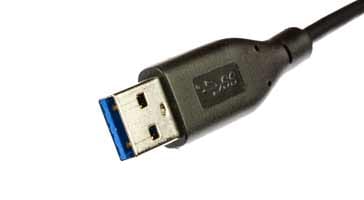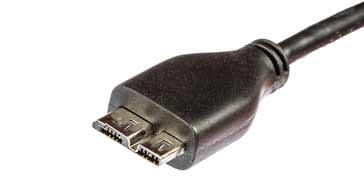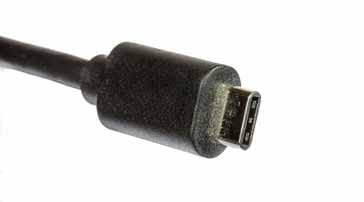USB 3.0 & USB 3.1: SuperSpeed
USB 3.0 & 3.1 are capable of providing data transfer at speeds of 5Gbps (USB3 / Superspeed) and 10 Gbps (USB3.1 / Superspeed+).
USB Universal Serial Bus Includes:
USB introduction
USB standards
Connectors, pinouts & cables
Data transfer & protocol
USB 3
USB-C
USB hubs
How to buy best USB hub
USB is used in many areas and for many data communications, storage, and short range transfer applications, and for this, the transfer speed is important.
USB 3.0 was launched in 2008 providing data transfer speeds of up to 5Gbps and was also called Superspeed because it gave a significant speed increase over the previous incarnations of USB.

Notice the blue insert on the connector that generally indicates USB 3
USB 3.1 also called Superspeed+ was launched in July 2013 and provided the capability for data transfer at speeds up to 10 Gbps. Often these two subsets are just referred to as USB 3.
These new versions of USB enable very rapid transfers of data and as such keep USB in line with the expectations of the market as data files increase in size and time is important.
Not only are much larger files required much faster, but also many laptop computers are using the USB C connector along with USB 3 as the main interface - often there may only be two USB C connections for the laptop.
This requires the use of dongles to expand the interfacing for everything from external backups, large screen displays, Ethernet connection for broadband and the like mean that the high speeds of USB 3 are required.
USB 3 capabilities
The USB 3.0, Superspeed and 3.1, Superspeed+ specifications enable much higher rates of data transfer. This is in keeping with requirements for downloading video and many other applications.
In terms of its speed USB 3.0 is theoretically up to ten times faster than USB 2. An example of how this work in reality is that it is possible to transfer a 25 GB HD movie to a media player in around 45 seconds, instead of about 8 minutes or more with USB 2.0.
Another improvement is with the power capabilities, enabling higher power devices to be supported.
A summary of the basic data rates for USB 3.0 and USB 3.1 is given in the table below:
| Performance Figures for USB 3 i.e. USB3.0 and USB 3.1 |
|||
|---|---|---|---|
| USB Version | Duplex Status | Transfer Speed | Increase over USB 2.0 |
| USB 2.0 | Half Duplex | 480 Mbps | --- |
| USB 3.0 - Superspeed | Full Duplex | 5 Gbps | 10 x |
| USB 3.1 - Superspeed+ | Full Duplex | 10 Gbps | 20 x |
In addition to the basic speed improvements, USB 3.0 and 3.1 provide other significant benefits as well.
Transfer speed: USB 3.0, Superspeed and USB 3.1 Superspeed+ both provide significant increases in data transfer speed over previous versions. This enables them to maintain their performance for applications requiring higher levels of data to be transferred within a given time.
A new transfer type called SuperSpeed or SS has been added and this enebles data transfer rates of up to 5 Gbps on USB 3.0 and 10 Gbps on 3.1. Electrically, the techniques behind SuperSpeed are similar to those used for PCI Express 2.0 and SATA.
- Duplex status: USB 1 and USB 2 only had the capability for half duplex transmissions, i.e. transmitting in one direction at any moment. USB 3.0 and USB 3.1 both have the capability for simultaneous transmission in both directions.
- Power management: Power management states U0 through U3 are supported.
- Bus utilisation improvements: The operation of the bus has been improved by the addition of a new feature where packets NRDY and ERDY can be used to let a device asynchronously notify the host of its readiness without the need for polling.
- Support to rotating media: Bulk protocol is updated with a new feature called Stream Protocol that allows a large number of logical streams within an Endpoint.

USB 3 compatibility
One key issue with any advance in a standard is the issue of backwards compatibility. For USB 3.0 and 3.1, a dual-bus architecture approach has been adopted. This enables both USB 2.0, including Full Speed, Low Speed, or High Speed as well as USB 3.0, SuperSpeed operations to take place simultaneously.
The new USB 3.0 has also been developed to enable forward compatibility. As a result it is possible to run USB 2.0 ports with USB 3.0 or 3.1 devices.
In terms of the topologies for links that can be used, these remain the same. This consists of a tiered star topology with a root hub at level 0. Then hubs at lower levels can provide bus connectivity to devices.
USB 3.0 / 3.1 annotation
In order to attain the very high speeds, some differences are required in the interface and this results in a different connector needing to be used.
That said the connectors are compatible, although the additional connections required for the higher performance will not be used when interfacing to a USB 2.0 port, cable or device.
In addition to the different connectors used on USB 3.0 cables, devices, etc, the cable are also distinguishable from their 2.0 counterparts by either the blue colour of the ports or the SS initials on the plugs.
Often devices with USB 3.0 capability are marked with the letters SS as well.

USB 3.0 / 3.1 connectors & connector pinouts
New USB connectors were introduced for USB 3.0. There was a Type A also introduced a new Micro-B cable plug, which consists of a standard USB 1.x/2.0 Micro-B cable plug, with an additional 5-pin plug "stacked" by the side of it.
That way, the USB 3.0 Micro-B host connector preserved its backward compatibility with the USB 1.x/2.0 Micro-B cable plugs, allowing devices with USB 3.0 Micro-B ports to run at USB 2.0 speeds on USB 2.0 Micro-B cables.
In terms of the actual connections within the USB 3 connectors, the original D+ and D- connections remain, along with the power and ground, but new twisted pair balanced drivers and receivers are used for the SuperSpeed data transfer.
These lines are labelled StdA_SSRX+ and StdA_SSRX- for the receive side and StdA_SSTX+ and StdA_SSTX- for the transmit side.
| USB 3.0 / USB 3.1 Connector Pinout |
||
|---|---|---|
| Pin Number | Connection Name | Wire colour |
| 1 | VBUS | Red |
| 2 | D- | White |
| 3 | D+ | Green |
| 4 | GND | Black |
| 5 | StdA_SSRX- | Blue |
| 6 | StdA_SSRX+ | Yellow |
| 7 | GND_DRAIN | GROUND |
| 8 | StdA_SSTX- | Purple |
| 9 | StdA_SSTX+ | Orange |
| Shell | Shield | Connector Shell |
Power management
The USB 3.0 specification incorporates new power management features that are far more sophisticated than before. It includes support for a variety of states including: idle, sleep, and suspend states. USB 3 also supports Link-, Device-, and Function-level power management.
The bus power capability has also been increased to 900mA. This is an 80% increase over USB 2.0 which stood at 500mA.
USB 3, both as 3.0 and 3.1 are able to provide the data transfer speeds required for many applications for which USB connections are used. The speed increase is partially important in areas like data backups for PCs where the increased levels of data mean that the higher speeds of USB 3.0 and USB 3.1 are welcomed. The speed improvements are also felt in many other areas where large amounts of data need to be transferred rapidly over a USB interface.
Wireless & Wired Connectivity Topics:
Mobile Communications basics
2G GSM
3G UMTS
4G LTE
5G
Wi-Fi
Bluetooth
IEEE 802.15.4
DECT cordless phones
Networking fundamentals
What is the Cloud
Ethernet
Serial data
USB
LoRa
VoIP
SDN
NFV
SD-WAN
Return to Wireless & Wired Connectivity


